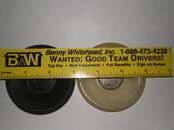My ebay magnehelic came today and I tested the cracking pressure on my two R109s. It proved to me that while I was able to improve on the hesitation issue by switching out the levers, the best I can can adjust the cracking pressure is about 1.6". The other I can adjust down to about .8"
I'm out of air right now so, I'm done for the day, but I played around with switching out diaphragms between the two. The lighter color diaphragm comes from the "good" 109. The black one comes with the reg causing the problems. As you can see, the center disk on the black diaphragm is smaller than an inch and the other is slightly larger than one inch. The center disk on the black diaphragm is plastic and is marked "patent pending." If you compare the two in a profile view, the black one is about 1/16" taller than the other. I'm not sure that the black one is a OEM Scubapro part or whether it is an aftermarket part. Switching out the diaphragms does seem to make a difference, but I've got to get more air to make sure.
Right now it looks like the problem may be a combination of the levers and the diaphragm. Looks like I'm in for more parts swapping tomorrow.




